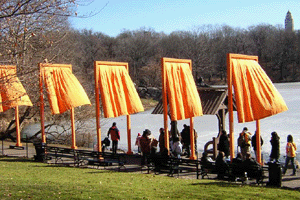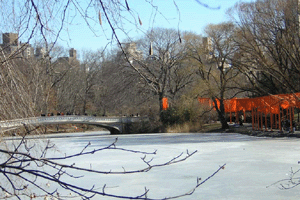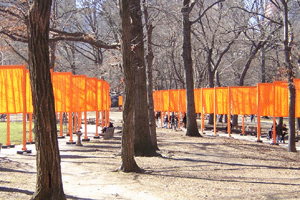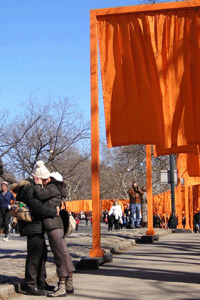3,500 saffron gates in central park
For the month of February 2005, two one-named artists, Cristo and Jean-Claude, dominated the water-cooler discussion, the front page news, and the pop culture reference every New Yorker understood. For 16 days, and at the highly advertised price of $21-$23 million dollars, Cristo erected 3,500 "saffron"-colored gates throughout Central Park. Spaced 15 feet apart over 23 miles of pathways, the steel frames stood 15 feet high with sails of rip-stop nylon suspended to 7 feet off the ground (all measurements are estimated). In the cold, dreary post-Christmas winter, this large-scale public art display supposedly brought to New York multi-millions of dollars in tourism in an otherwise relatively quiet time of year.

"What do you think of the Gates?" became the conversation starter, and even the occasional pick-up line, throughout the City. Several categories of discussion emerged, and several answers became repetitive. A lucky New Yorker would have a truly unique Gates-related story or opinion, but most resorted to repeating the thoughts so often expressed in the winter of 2005.
the visual effect
The Gates created a spectacular visual effect. From any point in the park, you might be surrounded overwhelmingly by billowing saffron towering over every path you chose to take, or, you might have found a rare spot where they only could be seen in the distance, through the leafless trees. Some visitors, as they first approached an entrance, reported the sensation of fear that a fire had swept through the park. Others waited anxiously to capture the sun-ray-colored material accentuated by the first snow fall during the installation. Enthusiasts did not simply walk through the Gates on a Sunday afternoon; they desired to experience their effect at night, in the wind, during a rainstorm, with no people, with busloads of tourists . . .

At some points in the Park, I could feel the calm and harmony that the artists continually implied would be apparent to anyone who experienced their masterpiece. When the gates followed a path with a consistent width and you could see the path wend through the trees ahead of you only because the gates provided that reference, the saffron seemed to compromise well with its surrounding environment. However, at many places in the park, I felt the covered paths coming at me from too many directions. Some paths, of different widths, ran parallel to each other, and the gates would be different sizes. This inconsistency threw off the previous harmony. The Gates definitely excelled where they seemed interwoven to the surrounding structures and nature, and they failed where the brassy color cowed its surroundings.
environmental considerations
Cristo and Jean-Claude have worked for decades to bring the Gates project to Central Park and among the many objections were the concerns for preserving the so-called "natural" state of Central Park. The Gates were designed not to cause any long-lasting degradation to the park; no holes were drilled to support the steel frames; no trees or branches were cut; I don't even think the gates rested on grass - always on preexisting pavement. Another concern was that the colors and drastic visual changes to the park would alter the behavior of the animals, primarily, that of the migratory birds. The only large area in the park free of saffron was The Ramble, the least groomed patch of flora and a heavily visited site for birdwatchers. It was interesting that this distinction of the Ramble was even further accentuated by the absense of Gates. Usually the Ramble provides a respite from the cars outside the park and the softball games within. During the Gates project, it provided an additional layer of peace, that from the Gates themselves.
More interesting than the physical changes to the environment is the message related when art and the environment mix. Over and over again, reporters described Central Park in February as cold, dreary, and uninteresting. The cold winter is just as natural as the warm summer, and yet, just like a rainstorm, people complain about the depressing winter. So, one of the prominent defenses for the Gates project was that it would bring color and energy to an otherwise grey and ugly park. Learning more about Cristo and Jean-Claude's other art projects decreases my acknowledgement of their justifications for installing such an intrusive display. Past creations include wrapping buildings and entire islands in material of a variety of loud colors. The Gates project also was coined a wrapping project: they wrapped the park with 23 miles of saffron paths.

What is the message when one of our most celebrated contemporary artists is engulfing nature in manmade materials? There is the potential for a statement about humans' dominance over nature, about materialism, about the need to have superficial elements to achieve beauty. But, Cristo and Jean-Claude never make that claim. Never have I heard a statement that their installations have any meaning besides their desire to create an aesthetic. And, I'd like to believe that I support art for art's sake; the Gates certainly allowed for many New Yorkers to converse about color and emotion and visual effects instead of the stock market or Paris Hilton.
Surely, there's a balance. Can we not intrigue artistic minds without the degradation and alteration of our environment?
people in the park in february
Despite the admittedly pretentious commentary concerning the artists' view of their own influence on the environment and natural surroundings, the Gates project provided a reason for urban dwellers to escape their dryly-heated apartments and unlimited NetFlix rentals by journeying outside, to Central Park, in February. How many New Yorkers have lived within ten blocks of the Park for years and have never seen its ponds frozen? By installing the Gates in the midst of winter, people absolutely had to experience trees, grass, and lakes under the natural influences of cold, northern temperatures. In this way, the Gates became an outreach project by encouraging people to venture outside, to enjoy their frosty breath, and possibly to observe a hawk devouring its prey behind a billowing curtain of firey saffron.
the price tag
Probably the most often discussed aspect of the Gates project was the price tag advertised repeated by Cristo and Jean-Claude. Almost every article about the installation mentioned the estimated $20-$23 Million for its implementation. For weeks, visitors tried to imagine being so rich to be able to spend that kind of money on an art project. Many brainstormed other uses for such a large chunk of cash; others questioned the rationale for using the sum for art rather than for charity.

Art is so difficult to justify in a time when so many people and causes are in such desperate need of money or basic neccesities. Art has always been a distinguishing product of human culture and society. There always will be and has been a more direct medium through which to use money to help people; when would art ever be thoroughly justified? And, why hold art to a different standard from any other "luxury" expense? Rich people buy expensive houses and own airplanes; Cristo and Jean--Claude chose to make a reality of a vision they dreamed about for decades, at no expense to anyone else and to the benefit of many urban dwellers. So, yes. The artists could have donated $20 Million to charity instead of realized their artistic vision, but its been their job, their dream, their passion; why should we expect any more selflessness from them than from anyone?
One of my favorite commentaries around the Gates project ran in the New York Times after the installation was over. The journalist examined what the $20-$23 Million estimate actually included. Apparently, numerous online bloggers had calculated the costs of the materials required for the project. After including the amount donated to the Central Park Conservancy, the payment to the City for additional security during the project, and funds for paying volunteers to set up, man, and break down the Gates, total budgets were still significantly lower than the advertised $20 Million.
The artists' only response to questions about the budget was to explain that a large-scale art project that had been in the making for two decades never could have a price-tag. How could you price the hours of meetings, consultations, and planning that had taken place?
But, back to the bloggers for a moment. It became a daunting task for people to figure out accurately how much the materials would cost to install 3,500 saffron gates. Some tried to track down where the original materials came from; others assumed the role of re-creating the project and called suppliers to ask how much the requisite amount of steel would cost. Apparently, these phone calls received little aid. Add to that dilemma that some parts were shipped from Europe, and it seems that the only people ever to know the real answers are Cristo and Jean-Claude.
conclusion
The Gates inspired a lot of discussion, a lot of contemplation, and a lot of controversy and debate. Artistically, they created a unique visual effect that dominated the image of New York for one month. And so, despite my initial skepticism, I am glad that I got to experience the Gates Project while living in New York City. We'll have to see if Cristo and Jean-Claude will progress in their future visions or if they will resort to the repetition of previous installations.
|

